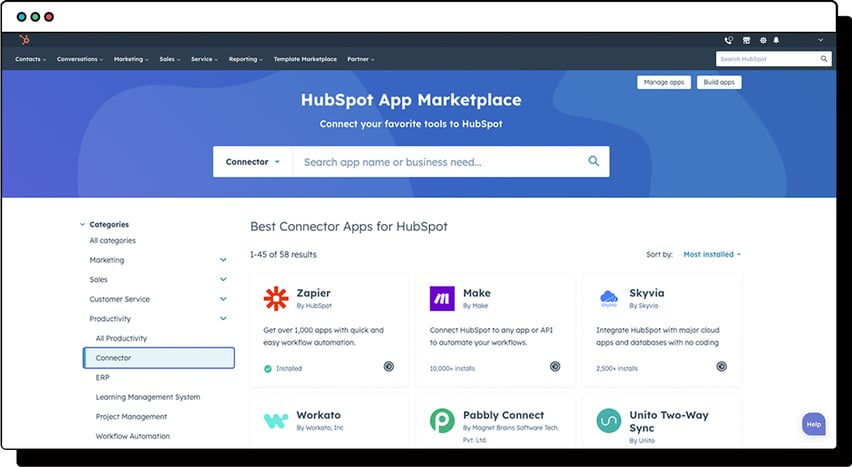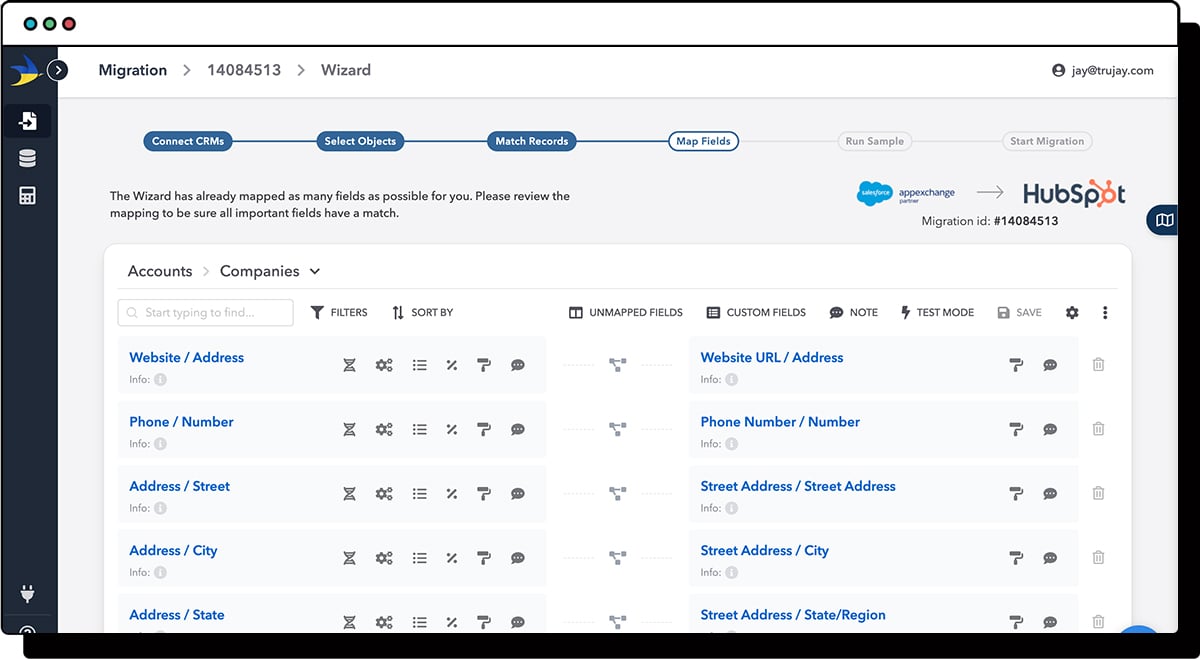Welcome to the world of CRM data migration! If you're reading this, you're likely considering or preparing to shift your valuable data into HubSpot, one of the leading CRMs on the market. It's a significant step for any business, big or small, and choosing the right path for this transition is crucial for a smooth and successful integration.
Data migration, especially to a robust system like HubSpot, can seem daunting. You may find yourself at a crossroads, wondering whether to take the plunge with a manual migration, lean on the ease of software like TruJay, or explore the various marketplace connectors available. Each of these paths offers its unique advantages and challenges, and the best choice largely depends on your specific business needs, data complexity, and resources.
Whether you're taking your first steps away from spreadsheets or dealing with intricate data systems, understanding these paths will equip you with the knowledge to make an informed decision. Let’s dive in and explore how to ensure your HubSpot data migration is as smooth and efficient as possible.

Understanding Data Migration
Before diving into the specifics of migrating to HubSpot, let's take a moment to understand what data migration really entails. In the simplest terms, data migration is the process of moving data from one system to another. However, it’s much more than just copying and pasting files from point A to point B. In the realm of CRM systems like HubSpot, data migration involves a strategic transfer of business-critical information - this could include customer details, sales records, interaction histories, and much more.
Why is data migration important? Well, in today's digital age, data is the lifeblood of any business. It informs your strategies, fuels your customer relations, and drives your growth. Migrating this data to a sophisticated CRM platform like HubSpot can transform the way you manage and interact with your customers. It allows for better data organisation, enhanced analysis, improved customer engagement, and ultimately, more informed business decisions.
However, as vital as it is, data migration isn't a one-size-fits-all process. The approach you choose must align with your business's scale, data complexity, and specific needs. A misstep here can lead to data loss, corruption, or disorganisation, which can have far-reaching consequences for your business operations. That's why understanding the pathways to HubSpot migration and the implications of each is a pivotal step in your CRM journey.

In the upcoming sections, we'll delve into the three primary routes that we at Struto use to help our clients with their HubSpot data migration:
-
Manual migration
-
TruJay
-
Marketplace connectors
Each of these avenues has its unique characteristics, benefits, and challenges. By the end of this blog, you'll have a clearer picture of which path is most aligned with your business’s migration needs and objectives.
Let's move forward and explore these options in detail.
Option 1: Manual Migration
When we talk about manual migration, we're referring to the process of moving data into HubSpot without the aid of specialised migration tools or services. This typically involves exporting data from your current system into a standard format like a CSV file and then importing it into HubSpot using its CSV import utility.

Pros of Manual Migration
-
Cost-effective: This is the most cost-effective solution, making it an attractive choice for businesses on a tight budget.
-
Control: You have complete control over the migration process, from data selection to import.
-
Simplicity: For smaller datasets with basic structures, this method can be straightforward and efficient.
Cons of Manual Migration
-
Time-consuming: Manual migration can be labour-intensive, especially if you have a large amount of data or complex data structures.
-
Error-prone: The manual process increases the risk of errors like data misalignment or loss, particularly if the data is complex.
-
Limited capability: It might not support advanced features like associating deals or importing certain types of data (e.g. emails and activities).
Who is manual migration ideal for?
Manual migration is best suited for smaller businesses or startups that don’t have a vast amount of data to move. If your data is simple in structure, primarily consisting of basic entities like contacts, companies, and deals, then your migration via this route should be relatively straightforward.
However, it’s important to note that while this method is cost-effective, it requires a meticulous approach. A single mistake in the CSV file can lead to significant data inconsistencies. Therefore, if this is opted for, it’s crucial to ensure that all data is checked and well-organised.
In summary, manual migration is like packing and moving your home by yourself. It's budget-friendly and gives you control, but it demands time, effort, and a bit of expertise. If your migration scope is small and your data is uncomplicated, this could be the right path for you.
Option 2: TruJay Migration
TruJay emerges as a popular choice for businesses seeking a more hands-off approach to their data migration to HubSpot. It’s a specialised tool that handles the complexities of transferring data into HubSpot, offering a blend of automation and customisation to suit various migration needs.
Pros of TruJay Migration
-
Versatility: TruJay supports a wide range of data types and complex structures, including companies, contacts, deals, notes, emails, and more.
-
Association preservation: It efficiently maintains relationships between different data types, like parent-child linkages, ensuring that data’s structural integrity is preserved.
-
Customisation and support: TruJay offers customised solutions for more intricate migration needs and provides expert support throughout the process.
Cons of TruJay Migration
-
Cost: Unlike manual migration, TruJay is a paid service, which might be a consideration for businesses with limited budgets.
-
Dependence on external service: You rely on an external team for your migration, which requires trust and sometimes a bit of patience, especially for complex migrations.
Who is Trujay migration ideal for?
TruJay is particularly well-suited for medium to large businesses or those with complex data systems. If the data migration involves a variety of data types, requires maintaining intricate relationships, or you simply want the peace of mind that comes with professional handling, TruJay is an excellent choice.
The service is also a boon for businesses transitioning from another CRM to HubSpot. For instance, if moving from a system like Salesforce or Pipedrive, TruJay’s specialised connectors make the process smoother and more reliable.
In essence, opting for TruJay is akin to hiring a professional moving company for your data. It brings expertise, efficiency, and peace of mind, especially for more complicated migration scenarios. However, it’s important to factor in the cost and the trust you’ll be placing in an external service.
Option 3: Marketplace Connectors
The third path involves using marketplace connectors available through the HubSpot ecosystem. These connectors are integration tools created by third-party developers to bridge HubSpot with various other systems and applications.

Pros of Marketplace Connectors
-
Diverse integration options: Marketplace connectors offer a wide range of integration possibilities, accommodating various platforms and services.
-
Flexibility: They allow for a more tailored approach to data migration, catering to specific needs and workflows.
-
Continuous synchronisation: Many connectors offer the benefit of ongoing data synchronisation, not just a one-time migration. This is particularly useful for businesses that need real-time data updates between systems.
Cons of Marketplace Connectors
-
Varied quality and reliability: Since these connectors are developed by third parties, their quality and reliability can vary.
-
Cost and subscription models: Some connectors come with their own subscription costs, adding to the overall expense of migration and ongoing data integration.
-
Technical know-how required: Setting up and managing these connectors might require a certain level of technical expertise or IT support.
Who is marketplace connector migration ideal for?
Marketplace connectors are ideal for businesses that are looking for a semi-automated migration process with the flexibility to integrate with a specific set of tools or platforms. They are particularly beneficial for companies that use a variety of software applications and need to ensure consistent data flow between these systems and HubSpot.
For instance, if a business heavily relies on Salesforce for CRM but also uses HubSpot for marketing automation, a marketplace connector can facilitate seamless data exchange between the two systems. This integration ensures that sales and marketing efforts are perfectly aligned, leveraging the strengths of both platforms.
In summary, choosing marketplace connectors is like opting for a modular moving service that lets you pick and choose specific services according to your needs. It offers flexibility and ongoing integration capabilities, but it also demands careful consideration of quality, costs, and technical requirements.
Comparative Analysis
This table provides a clear and concise comparison of the options, making it easier to understand the strengths and limitations of each approach.
|
Criteria
|
Manual Migration
|
TruJay Migration
|
Marketplace Connectors
|
|
Cost and Budget |
Most cost-effective; ideal for tight budgets. |
Involves financial investment for comprehensive services. |
Costs vary; some connectors may require subscriptions. |
|
Complexity and Data Volume |
Best for small-scale, simple data sets. |
Handles complex, large-scale migrations efficiently. |
Suitable for various data types; good for dynamic data needs. |
|
Ease of Use and Technical Requirements |
Hands-on approach; basic technical know-how needed. |
Minimal user effort; relies on TruJay’s expertise. |
May need technical understanding or IT support. |
|
Control and Customisation |
Complete control but limited customisation. |
Professional handling with customised solutions. |
Flexible, customisable to specific integration needs. |
|
Reliability and Support |
Depends on user accuracy; limited HubSpot support. |
High reliability with professional support. |
Varies by connector; some offer dedicated support. |
|
Integration with Other Systems |
Limited to data import without integration. |
Specialised connectors for specific CRMs. |
Ideal for ongoing integration with multiple systems. |
Conclusion
Choosing the right path for your data migration to HubSpot is a decision that carries significant implications for your business’s efficiency and future growth. Whether you opt for the hands-on approach of manual migration, the expert-driven route of TruJay, or the specialised integration offered by marketplace connectors, the key lies in aligning your choice with your business needs, resources, and goals.
Remember, successful data migration is more than just transferring information from one place to another; it’s about setting up a foundation for better customer relationships, insightful data analysis, and streamlined business operations. With the right approach, HubSpot can become a powerful tool in your arsenal, driving your business towards new heights of success.
If you’re ready to take the next step in your HubSpot data migration journey but still have questions or need guidance? Don't navigate this critical path alone. Book a call with Struto - our team of experts is ready to assist you in crafting a migration strategy that’s tailored to your unique business needs.


